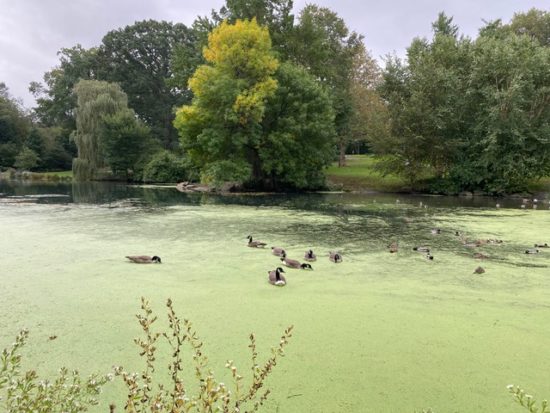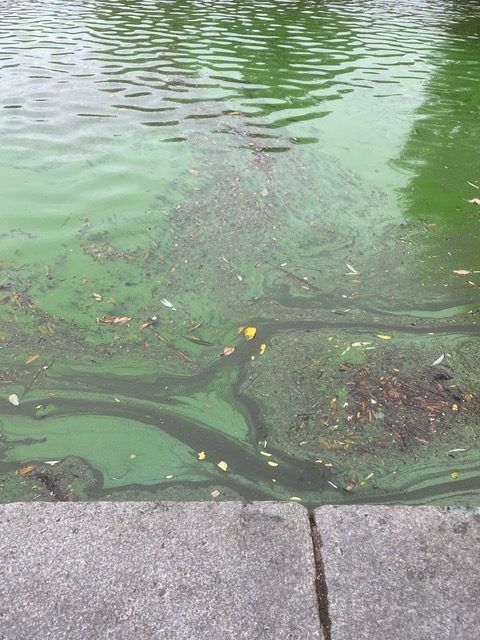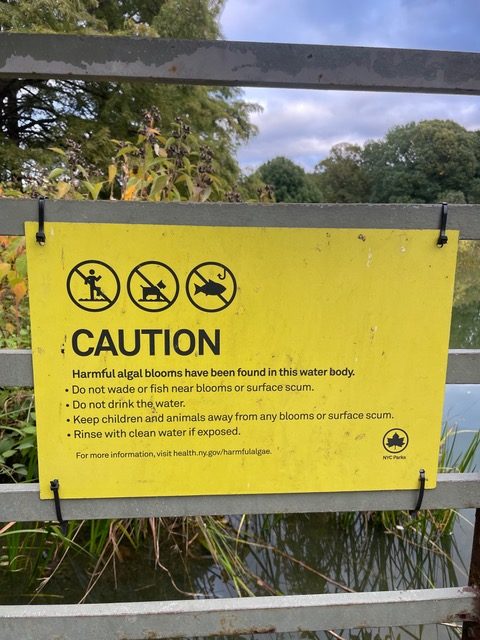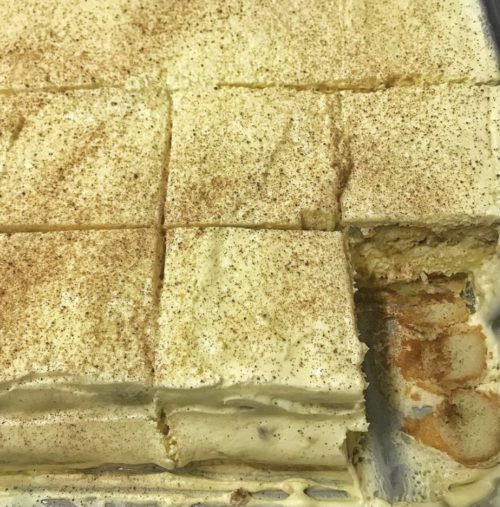
By Lisa Kava
Did you ever stroll to edge of the Turtle Pond or the Lake in Central Park or the Harlem Meer, hoping to gaze upon their sparkling blueness, only to discover they were covered with a vile green slime?
This phenomenon is often caused by algae blooms, which form in warmer weather, according to Rebecca Gorney, a research scientist from the New York State Department of Environmental Conservation (DEC). “Algae blooms commonly occur between May and October, dissipating when the weather cools,” Gorney explained. The DEC works in partnership with both the Central Park Conservancy and the NYC Parks Department to monitor Central Park’s water bodies for algae that might be dangerous.

While some algae blooms are harmless, others, known as Harmful Algal Blooms (HABs) can be toxic to people and pets. HABs can cause a variety of illnesses, ranging from gastrointestinal upset to respiratory illness, to neurological symptoms, according to the Parks Department website. Symptoms and illness can occur from ingesting or simply touching affected water. “The toxins emitted from HABs can be especially dangerous for dogs, so we as ask our visitors to follow all dog-walking rules and etiquette outlined by NYC Parks,” a Central Park Conservancy spokesperson said.
HABs have been confirmed as recently as October 5th in the Turtle Pond and The Lake, and September 13th in The Harlem Meer, Gorney said. Yellow signs are posted by the NYC Parks Department, indicating the presence of these harmful blooms, which should be avoided. “These three lakes have experienced this phenomenon annually since routine reporting began in 2015. HABs are not commonly reported on other waterbodies in Central Park,” Gorney said.
“Cyanobacteria thrive in warm temperatures. Late summer and early fall are generally when the water is warmest and when DEC receives the highest number of HAB reports each year,” Gorney told West Side Rag. “They prefer warm conditions more than other types of algae.” Both harmless algae and HABs might look like “pea soup, a green paint spill, or thin blue or green mats, but HABs often appear as a murky greenish foam on top of water surfaces,” the Central Park Conservancy spokesperson said.
Because it is difficult to the untrained eye to tell the difference between non harmful blooms and HABs, all three agencies recommend avoiding water bodies with any algae.
Photos of HABs can be found on the DEC website here:
https://www.dec.ny.gov/chemical/81962.html
More information on HABs and safety tips can be found here: https://www.nycgovparks.org/about/harmful-algal-blooms











Not to be confused with duck weed, Which can cover the surface.
How do you write an article about pond scum in New York City without mentioning a single politician?
Its not just NYC.
honest question from a city slicker. How difficult would it be to skim the algae a couple of times a week? Is there an ecological reason to let it continue to bloom all the time?
Skimming is a challenge because they quickly replicate and the blooms will proliferate very quickly. This makes skimming a never ending saga.
However, the three ponds are all fed from the NYC water system. The algal blooms are a product of the overabundance of fertilizer in the water. Maybe the answer is to drain the the water bodies over the winter and refill them. It will take years for the fertilizer levels to increase back to high enough cause the blooms. The Lake and Reservoir are both much larger water bodies, so the level of fertilizer is lower, since more water is diluting them.
Not difficult at all. Obviously much less expensive to do nothing aside from putting up a few signs.
It’s always something… especially these days.
I’d blame trump, except I always blame trump.
I blame you for always blaming Trump.
Does this relate to the green growth that appears on window sills? I have green growth on wide window sills that face the park.
I’m another city slicker who doesn’t know if there’s any relationship at all, but have always wondered about the health factor.